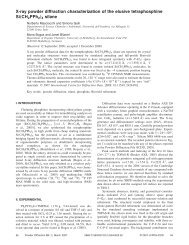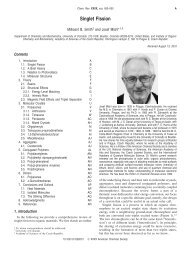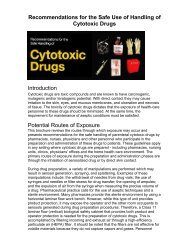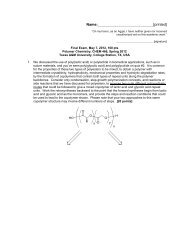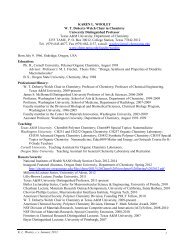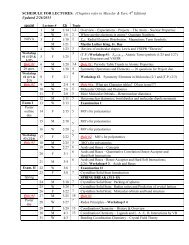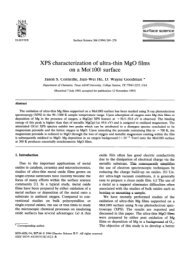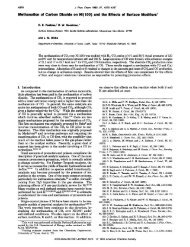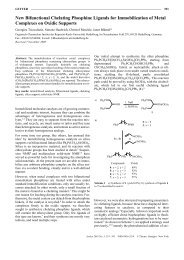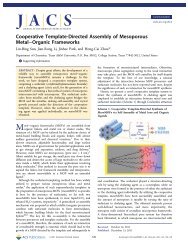Radical salts of TTF derivatives with the metal–metal bonded [Re2Cl8]
Radical salts of TTF derivatives with the metal–metal bonded [Re2Cl8]
Radical salts of TTF derivatives with the metal–metal bonded [Re2Cl8]
You also want an ePaper? Increase the reach of your titles
YUMPU automatically turns print PDFs into web optimized ePapers that Google loves.
<strong>Radical</strong> <strong>salts</strong> <strong>of</strong> <strong>TTF</strong> <strong>derivatives</strong> <strong>with</strong> <strong>the</strong> <strong>metal–metal</strong> <strong>bonded</strong> [Re 2Cl 8] 2 anion<br />
Eric W. Reinheimer a,c , José R. Galán-Mascarós b,1 , Carlos J. Gómez-García b , Hanhua Zhao a ,<br />
Marc Fourmigué c,2 , Kim R. Dunbar a, *<br />
a Department <strong>of</strong> Chemistry, Texas A&M University, P.O. Box 30012, College Station, TX 77842-3012, USA<br />
b Instituto de Ciencia Molecular, Fundación de la Universidad de Valencia, Polígono de la Coma s/n, 46980-Paterna, Spain<br />
c Sciences Chimiques de Rennes, UMR 6226 CNRS-Université Rennes 1, Campus de Beaulieu, 35042 Rennes, France<br />
article info<br />
Article history:<br />
Received 11 December 2007<br />
Received in revised form 14 March 2008<br />
Accepted 19 March 2008<br />
Available online 6 April 2008<br />
Keywords:<br />
<strong>TTF</strong><br />
BEDT-<strong>TTF</strong><br />
TM<strong>TTF</strong><br />
TMTSF<br />
o-Me 2<strong>TTF</strong><br />
Octachlorodirhenate<br />
1. Introduction<br />
abstract<br />
The field <strong>of</strong> organic conductors is one <strong>of</strong> <strong>the</strong> most developed<br />
areas in molecular materials because <strong>of</strong> <strong>the</strong> many innovative findings<br />
that <strong>the</strong> field has witnessed in <strong>the</strong> past few decades. Organicbased<br />
conductors have been found to exhibit properties reminiscent<br />
<strong>of</strong> traditional inorganic solids, <strong>with</strong> examples <strong>of</strong> semiconductors,<br />
metals and even superconductors having been discovered [1].<br />
An intrinsic advantage <strong>of</strong> molecular materials is <strong>the</strong> flexibility in<br />
tuning by chemical alterations. Indeed such methods have been<br />
successful in applied research applications since <strong>the</strong> early development<br />
<strong>of</strong> conducting polymers [2]. With respect to fundamental<br />
studies, research in molecular conductors has led to several milestones<br />
in materials science such as <strong>the</strong> preparation <strong>of</strong> paramagnetic<br />
and antiferromagnetic superconductors, ferromagnetic<br />
metals, field-induced superconductors, chiral conductors and single-component<br />
metals [3–7].<br />
Most <strong>of</strong> <strong>the</strong> organic metals and superconductors reported to<br />
date belong to <strong>the</strong> tetrathiafulvalene (<strong>TTF</strong>) family <strong>of</strong> radical <strong>salts</strong><br />
or its <strong>derivatives</strong>. These materials are composed <strong>of</strong> partially oxi-<br />
* Corresponding author. Tel.: +1 979 845 5235; fax: +1 979 845 7177.<br />
E-mail addresses: ereinheimer@mail.chem.tamu.edu (E.W. Reinheimer), jose.r.<br />
galan@uv.es (J.R. Galán-Mascarós), marc.fourmigue@univ-rennes1.fr (M. Fourmigué),<br />
dunbar@mail.chem.tamu.edu (K.R. Dunbar).<br />
1<br />
Tel.: +34 96354 4420; fax: +34 96354 3273.<br />
2<br />
Tel.: +33 0223236732; fax: +33 0223235243.<br />
0022-2860/$ - see front matter Ó 2008 Elsevier B.V. All rights reserved.<br />
doi:10.1016/j.molstruc.2008.03.046<br />
Journal <strong>of</strong> Molecular Structure 890 (2008) 81–89<br />
Contents lists available at ScienceDirect<br />
Journal <strong>of</strong> Molecular Structure<br />
journal homepage: www.elsevier.com/locate/molstruc<br />
Four new <strong>salts</strong> <strong>of</strong> <strong>the</strong> radical cations <strong>of</strong> TMTSF (tetramethyltetraselenafulvalene), TM<strong>TTF</strong> (tetramethyltetrathiafulvalene),<br />
BEDT-<strong>TTF</strong> (bisethylenedithiotetrathia-fulvalene) (ET) and o-Me2<strong>TTF</strong> (o-4,4 0 -dimethyltetrathiafulvalene)<br />
<strong>with</strong> <strong>the</strong> <strong>metal–metal</strong> <strong>bonded</strong> dianion [<strong>Re2Cl8</strong>] 2 were syn<strong>the</strong>sized, and <strong>the</strong>ir<br />
structures and physical properties investigated. The structures <strong>of</strong> <strong>the</strong>se semiconducting <strong>salts</strong> feature<br />
one-dimensional stacking <strong>of</strong> <strong>the</strong> donor molecules interleaved <strong>with</strong> [<strong>Re2Cl8</strong>] 2 anions and interstitial solvent<br />
molecules.<br />
Ó 2008 Elsevier B.V. All rights reserved.<br />
dized <strong>TTF</strong> units that form segregated stacks in <strong>the</strong> solid state due<br />
to strong S S contacts which lead to <strong>the</strong> electron delocalization<br />
responsible for <strong>the</strong> transport properties. While <strong>the</strong> presence <strong>of</strong> oxidized<br />
radicals <strong>of</strong> <strong>the</strong> <strong>TTF</strong> family is essential for <strong>the</strong> observation <strong>of</strong><br />
conducting properties in hybrid organic/inorganic materials, <strong>the</strong><br />
organic component has allowed for <strong>the</strong> observation <strong>of</strong> several phenomena<br />
from solid-state physics including Peierls transitions, anion<br />
ordering, spin density waves (SDWs), magnetic frustration,<br />
charge localization (Mott transitions), charge ordering (CO), Anderson<br />
localizations and field effect transitions [8–15]. Typically <strong>the</strong><br />
anions in <strong>the</strong> <strong>salts</strong> do not contribute to <strong>the</strong> transport properties,<br />
but <strong>the</strong>ir role is none<strong>the</strong>less crucial. It has been found that <strong>the</strong><br />
shape, size, charge and chemical properties help to control <strong>the</strong> type<br />
<strong>of</strong> stack that <strong>the</strong> <strong>TTF</strong> molecules adopt as well <strong>the</strong> overall charge <strong>of</strong><br />
<strong>the</strong> cationic units. Thus, given a particular <strong>TTF</strong> derivative, one can<br />
obtain insulators, semiconductors, metals or even superconductors<br />
by changing <strong>the</strong> identity <strong>of</strong> <strong>the</strong> anion. The bis(ethylene)dithio-<strong>TTF</strong><br />
donor, (BEDT-<strong>TTF</strong> or ET), has produced <strong>the</strong> largest number <strong>of</strong><br />
molecular conductors <strong>with</strong> diverse transport properties, e.g., (ET)[-<br />
FeBr4] is an insulator, (ET) 8[PNi(H 2O)W 11O 39] 2H 2O is a semiconductor,<br />
(ET)3[CuCl4] H2O is a metal and j-(ET)2Cu[N(CN)2]Cl is a<br />
superconductor, <strong>with</strong> a T c <strong>of</strong> 12.8 K at 0.3 kbar, <strong>the</strong> highest T c for<br />
a superconducting state for a molecular conductor <strong>with</strong> <strong>the</strong> exception<br />
<strong>of</strong> fullerene-based materials [16–20].<br />
Given <strong>the</strong> many factors involved in determining <strong>the</strong> packing <strong>of</strong> a<br />
radical salt, including weak intermolecular interactions, it is difficult<br />
to predict <strong>the</strong> final structure and properties. In order to probe
82 E.W. Reinheimer et al. / Journal <strong>of</strong> Molecular Structure 890 (2008) 81–89<br />
<strong>the</strong> landscape <strong>of</strong> possibilities, researchers have amassed a library <strong>of</strong><br />
<strong>salts</strong> <strong>with</strong> different anions over <strong>the</strong> years. Among <strong>the</strong> known examples,<br />
only two radical cation <strong>salts</strong> <strong>with</strong> <strong>metal–metal</strong> <strong>bonded</strong> anions<br />
have been reported to date, namely <strong>the</strong> compound<br />
Fig. 1. X-ray crystal structure <strong>of</strong> (TM<strong>TTF</strong>) 3[Re 2Cl 8] 2CH 3CN (1 2CH 3CN). Interstitial<br />
acetonitrile molecules have been omitted for <strong>the</strong> sake <strong>of</strong> clarity.<br />
Fig. 2. X-ray crystal structure <strong>of</strong> (TMTSF) 5[Re 2Cl 8] 2 6CH 2Cl 2 (2 6CH 2Cl 2). Interstitial<br />
dichloromethane molecules have been omitted for <strong>the</strong> sake <strong>of</strong> clarity.<br />
(ET)3[Re2(NCS)10] 2CH2Cl2 which is a semiconductor and a salt <strong>of</strong><br />
[<strong>Re2Cl8</strong>] 2<br />
and dimethyl(diphenyl)<strong>TTF</strong> (DMDPh<strong>TTF</strong>) reported in<br />
1991 by Ouahab and coworkers [21,22]. No properties <strong>of</strong> <strong>the</strong> latter<br />
material were reported. Several charge transfer <strong>salts</strong> containing<br />
Fig. 3. X-ray crystal structure <strong>of</strong> (BEDT-<strong>TTF</strong>)2[<strong>Re2Cl8</strong>] (3).<br />
Fig. 4. X-ray crystal structure <strong>of</strong> (o- Me2<strong>TTF</strong>)2[<strong>Re2Cl8</strong>] (4).<br />
Table 1<br />
X-ray crystallographic and refinement data for (1 2CH 3CN) and (2 6CH 2Cl 2)<br />
Compound (TM<strong>TTF</strong>)3[<strong>Re2Cl8</strong>] 2CH3CN (TMTSF)5[<strong>Re2Cl8</strong>]2 6CH2Cl2<br />
(1 2CH3CN)<br />
(2 6CH2Cl2)<br />
Formula C34H42S12N2<strong>Re2Cl8</strong> C53H66Se20Re4Cl22 Formula weight 1515.66 3817.98<br />
Space group P1 P1<br />
a (Å) 10.542(2) 13.042(3)<br />
b (Å) 13.786(3) 14.022(3)<br />
c (Å) 19.664(4) 15.283(3)<br />
a (°) 100.64(3) 93.84(3)<br />
b (°) 104.87(3) 103.51(3)<br />
c (°) 107.66(3) 109.76(3)<br />
Volume (Å 3 ) 2522.82 2524.91<br />
Z 4 4<br />
l, (mm 1 ) 10.76 25.53<br />
Temp. 110(2) 110(2)<br />
Reflns. collected 11560 11339<br />
Reflns. I >2r 10068 8429<br />
Parameters 537 467<br />
Restraints 0 0<br />
R a<br />
1<br />
wR<br />
0.0339 0.0992<br />
b<br />
2<br />
Goodness-<strong>of</strong>-fit<br />
0.0930 0.2746<br />
c<br />
1.042 1.064
Table 2<br />
X-ray crystallographic and refinement data for 3 and 4<br />
Compound (BEDT-<strong>TTF</strong>)2[<strong>Re2Cl8</strong>] (3) (o-Me2<strong>TTF</strong>)2[<strong>Re2Cl8</strong>] (4)<br />
Formula C20S16<strong>Re2Cl8</strong> C16H16S8<strong>Re2Cl8</strong> Formula weight 1409.28 1117.56<br />
Space group P1 P1<br />
a (Å) 10.404(2) 8.7469(4)<br />
b (Å) 12.843(3) 10.6444(5)<br />
c (Å) 15.622(3) 16.5506(8)<br />
a (°) 97.16(3) 79.058(2)<br />
b (°) 105.25(3) 81.276(2)<br />
c (°) 100.91(3) 88.963(2)<br />
Volume (Å 3 ) 1943.75 1495.34(12)<br />
Z 3 4<br />
l (mm 1 ) 11.48 9.372<br />
Temp. 110(2) 110(2)<br />
Reflns. collected 4955 6810<br />
Reflns. I >2r 3461 5330<br />
Parameters 410 307<br />
Restraints 0 0<br />
R a<br />
1<br />
wR<br />
0.0735 0.0410<br />
b<br />
2<br />
Goodness-<strong>of</strong>-fit<br />
0.1038 0.0898<br />
c<br />
1.014 1.081<br />
Table 3<br />
Bond distances for (TM<strong>TTF</strong>) 3[Re 2Cl 8] 2CH 3CN (1 2CH 3CN) in Å<br />
Re(1)–Re(2) 2.2253(8) S(11)–C(26) 1.718(4)<br />
Re(1)–C1(1) 2.3230(12) S(11)–C(29) 1.751(4)<br />
Re(1)–C1(2) 2.3271(12) S(12)–C(26) 1.726(4)<br />
Re(1)–C1(3) 2.3317(14) S(12)–C(28) 1.742(4)<br />
Re(1)–C1(4) 2.3304(11) C(1)–C(2) 1.505(6)<br />
Re(2)–C1(5) 2.3186(14) C(2)–C(3) 1.338(6)<br />
Re(2)–C1(6) 2.3344(11) C(3)–C(4) 1.507(6)<br />
Re(2)–C1(7) 2.3367(12) C(5)–C(6) 1.357(6)<br />
Re(2)–C1(8) 2.3263(13) C(7)–C(8) 1.499(6)<br />
S(1)–C(2) 1.760(4) C(8)–C(9) 1.341(6)<br />
S(1)–C(5) 1.750(4) C(9)–C(10) 1.492(6)<br />
S(2)–C(3) 1.761(4) C(11)–C(12) 1.500(6)<br />
S(2)–C(5) 1.751(4) C(12)–C(13) 1.362(6)<br />
S(3)–C(6) 1.752(4) C(13)–C(14) 1.491(6)<br />
S(3)–C(8) 1.758(4) C(15)–C(16) 1.399(5)<br />
S(4)–C(6) 1.748(4) C(17)–C(18) 1.506(6)<br />
S(4)–C(9) 1.755(4) C(18)–C(19) 1.350(6)<br />
S(5)–C(12) 1.738(4) C(19)–C(20) 1.499(5)<br />
S(5)–C(15) 1.721(4) C(21)–C(22) 1.499(6)<br />
S(6)–C(13) 1.740(4) C(22)–C(23) 1.360(6)<br />
S(6)–C(15) 1.716(4) C(23)–C(24) 1.496(6)<br />
S(7)–C(16) 1.716(4) C(25)–C(26) 1.392(5)<br />
S(7)–C(19) 1.732(4) C(27)–C(28) 1.489(6)<br />
S(8)–C(16) 1.713(4) C(28)–C(29) 1.352(6)<br />
S(8)–C(18) 1.731(4) C(29)–C(30) 1.491(6)<br />
S(9)–C(22) 1.729(4) C(31)–C(32) 1.438(8)<br />
S(9)–C(25) 1.725(4) C(33)–C(34) 1.442(8)<br />
S(10)–C(23) 1.737(4) C(32)–N(1) 1.136(7)<br />
S(10)–C(25) 1.710(4) C(34)–N(2) 1.137(8)<br />
o<strong>the</strong>r rhenium-based anions, more specifically octahedral clusters,<br />
have also been prepared [23]. In this article we report <strong>the</strong> syn<strong>the</strong>ses<br />
and characterization <strong>of</strong> four new radical <strong>salts</strong> <strong>of</strong> <strong>the</strong> quadruply<br />
<strong>bonded</strong> dianion [<strong>Re2Cl8</strong>] 2<br />
and <strong>the</strong> donors tetra(methyl)<strong>TTF</strong><br />
(TM<strong>TTF</strong>), <strong>the</strong> selenium derivative tetramethyltetraselenafulvalene<br />
(TMTSF), o-Me2<strong>TTF</strong> and ET.<br />
2. Experimental<br />
2.1. Syn<strong>the</strong>ses<br />
The radical <strong>salts</strong> were syn<strong>the</strong>sized at platinum wire electrodes<br />
<strong>of</strong> dimensions 1 mm in diameter and 2 cm in length by electrochemical<br />
oxidation <strong>of</strong> <strong>the</strong> donor in a U- or H-shaped cell under<br />
E.W. Reinheimer et al. / Journal <strong>of</strong> Molecular Structure 890 (2008) 81–89 83<br />
<strong>the</strong> application <strong>of</strong> a low constant current at room temperature<br />
[24]. TMTSF and ET were used as received <strong>with</strong>out fur<strong>the</strong>r purification.<br />
TM<strong>TTF</strong>, o-Me2<strong>TTF</strong> and [TBA]2[<strong>Re2Cl8</strong>] were prepared using literature<br />
methods [25–27].<br />
2.1.1. (TM<strong>TTF</strong>) 3[Re 2Cl 8] 2CH 3CN(1 2CH 3CN)<br />
(TBA)2[<strong>Re2Cl8</strong>] (0.100 g, 0.088 mmol) was added to each compartment<br />
<strong>of</strong> <strong>the</strong> electrochemical cell in 10 mL <strong>of</strong> CH 3CN. TM<strong>TTF</strong><br />
(0.020 g, 0.077 mmol) was added to <strong>the</strong> anodic compartment and<br />
<strong>the</strong> cell was subjected to <strong>the</strong> application <strong>of</strong> a constant current density<br />
<strong>of</strong> 0.5 lA. After a period <strong>of</strong> 2 weeks, black block-shaped crystals<br />
<strong>of</strong> <strong>the</strong> product formed on <strong>the</strong> electrode surface which were removed,<br />
washed <strong>with</strong> MeCN and dried in air.<br />
Table 4<br />
Bond distances for (TMTSF) 5[Re 2Cl 8] 2 6CH 2Cl 2 (2 6CH 2Cl 2)inÅ<br />
Re(1)–Re(2) 2.257(16) Se(9)–C(22) 1.89(2)<br />
Re(1)–Cl(1) 2.340(5) Se(10)–C(21) 1.87(2)<br />
Re(1)–Cl(2) 2.320(5) Se(10)–C(23) 1.86(2)<br />
Re(1)–Cl(3) 2.329(5) C(1)–C(2) 1.47(3)<br />
Re(1)–Cl(4) 2.329(5) C(2)–C(3) 1.36(3)<br />
Re(2)–Cl(5) 2.327(5) C(3)–C(4) 1.53(5)<br />
Re(2)–Cl(6) 2.327(5) C(5)–C(5) 1.40(4)<br />
Re(2)–Cl(7) 2.331(5) C(6)–C(7) 1.52(3)<br />
Re(2)–Cl(8) 2.330(5) C(7)–C(8) 1.32(3)<br />
Se(1)–C(3) 1.84(2) C(8)–C(9) 1.50(3)<br />
Se(1)–C(5) 1.87(2) C(10)–C(11) 1.38(3)<br />
Se(2)–C(2) 1.90(2) C(12)–C(13) 1.37(3)<br />
Se(2)–C(5) 1.85(2) C(12)–C(15) 1.50(3)<br />
Se(3)–C(7) 1.88(2) C(13)–C(14) 1.48(3)<br />
Se(3)–C(10) 1.87(2) C(16)–C(17) 1.43(3)<br />
Se(4)–C(8) 1.91(2) C(17)–C(18) 1.36(3)<br />
Se(4)–C(10) 1.86(2) C(18)–C(19) 1.50(3)<br />
Se(5)–C(11) 1.87(2) C(20)–C(21) 1.38(3)<br />
Se(5)–C(12) 1.88(2) C(22)–C(23) 1.39(3)<br />
Se(6)–C(11) 1.90(2) C(22)–C(25) 1.47(3)<br />
Se(6)–C(13) 1.89(2) C(26)–C1(9) 1.76(3)<br />
Se(7)–C(17) 1.90(2) C(26)–C1(10) 1.75(3)<br />
Se(7)–C(20) 1.86(2) C(27)–C1(11) 1.72(3)<br />
Se(8)–C(18) 1.868(19) C(27)–C1(12) 1.78(3)<br />
Se(8)–C(20) 1.89(2) C(28)–C1(13) 1.77(3)<br />
Se(9)–C(21) 1.86(2) C(28)–C1(14) 1.64(3)<br />
Table 5<br />
Bond distances for (BEDT-<strong>TTF</strong>)2[<strong>Re2Cl8</strong>] (3) inÅ<br />
Re(1)–Re(1) 2.231(19) S(9)–C(11) 1.72(3)<br />
Re(2)–Re(2) 2.222(18) S(9)–C(13) 1.74(2)<br />
Re(1)–Cl(1) 2.337(5) S(10)–C(12) 1.73(3)<br />
Re(1)–Cl(2) 2.340(5) S(10)–C(14) 1.72(2)<br />
Re(1)–Cl(3) 2.335(5) S(11)–C(13) 1.74(2)<br />
Re(1)–Cl(4) 2.318(5) S(11)–C(15) 1.70(2)<br />
Re(2)–Cl(5) 2.334(5) S(12)–C(14) 1.77(2)<br />
Re(2)–Cl(6) 2.335(5) S(12)–C(15) 1.73(2)<br />
Re(2)–Cl(7) 2.308(6) S(13)–C(16) 1.72(2)<br />
Re(2)–Cl(8) 2.334(6) S(13)–C(17) 1.75(2)<br />
S(1)–C(1) 1.81(2) S(14)–C(16) 1.74(2)<br />
S(1)–C(3) 1.72(2) S(14)–C(18) 1.76(2)<br />
S(2)–C(2) 1.80(3) S(15)–C(17) 1.748(18)<br />
S(2)–C(4) 1.78(2) S(15)–C(19) 1.79(3)<br />
S(3)–C(3) 1.77(2) S(16)–C(18) 1.76(2)<br />
S(3)–C(5) 1.70(2) S(16)–C(20) 1.73(3)<br />
S(4)–C(4) 1.74(2) C(1)–C(2) 1.44(3)<br />
S(4)–C(5) 1.731(19) C(3)–C(4) 1.31(3)<br />
S(5)–C(6) 1.706(19) C(5)–C(6) 1.41(3)<br />
S(5)–C(7) 1.76(2) C(7)–C(8) 1.42(3)<br />
S(6)–C(6) 1.73(2) C(9)–C(10) 1.45(3)<br />
S(6)–C(8) 1.71(2) C(11)–C(12) 1.33(4)<br />
S(7)–C(7) 1.71(2) C(13)–C(14) 1.33(3)<br />
S(7)–C(9) 1.83(2) C(15)–C(16) 1.39(3)<br />
S(8)–C(8) 1.71(2) C(17)–C(18) 1.32(3)<br />
S(8)–C(10) 1.79(2) C(19)–C(20) 1.38(4)
84 E.W. Reinheimer et al. / Journal <strong>of</strong> Molecular Structure 890 (2008) 81–89<br />
Table 6<br />
Bond distances for (o-Me 2<strong>TTF</strong>) 2[Re 2Cl 8](4) inÅ<br />
Re(1)–Re(2) 2.2249(4)<br />
Re(1)–Cl(8) 2.3071(18)<br />
Re(1)–Cl(5) 2.3267(17)<br />
Re(1)–Cl(6) 2.3385(16)<br />
Re(1)–Cl(7) 2.3411(18)<br />
Re(2)–Cl(3) 2.3158(18)<br />
Re(2)–Cl(2) 2.3254(16)<br />
Re(2)–Cl(4) 2.3279(18)<br />
Re(2)–Cl(1) 2.3378(17)<br />
S(1A)–C(5A) 1.722(7)<br />
S(1A)–C(3A) 1.742(7)<br />
S(2A)–C(5A) 1.702(7)<br />
S(2A)–C(4A) 1.728(7)<br />
S(3A)–C(6A) 1.712(7)<br />
S(3A)–C(7A) 1.727(8)<br />
S(4A)–C(8A) 1.700(8)<br />
S(4A)–C(6A) 1.724(7)<br />
C(1A)–C(3A) 1.502(9)<br />
C(2A)–C(4A) 1.508(9)<br />
C(3A)–C(4A) 1.337(9)<br />
C(5A)–C(6A) 1.401(8)<br />
C(7A)–C(8A) 1.342(11)<br />
S(1B)–C(5B) 1.713(7)<br />
S(1B)–C(3B) 1.746(7)<br />
S(2B)–C(4B) 1.727(7)<br />
S(2B)–C(5B) 1.727(6)<br />
S(3B)–C(7B) 1.717(9)<br />
S(3B)–C(6B) 1.718(7)<br />
S(4B)–C(6B) 1.718(7)<br />
S(4B)–C(8B) 1.719(10)<br />
C(1B)–C(3B) 1.485(10)<br />
C(2B)–C(4B) 1.491(9)<br />
C(3B)–C(4B) 1.356(10)<br />
2.1.2. (TMTSF) 5[Re 2Cl 8] 2 6CH 2Cl 2(2 6CH 2Cl 2)<br />
(TBA)2[<strong>Re2Cl8</strong>] (0.102 g, 0.090 mmol) was added to each compartment<br />
<strong>of</strong> <strong>the</strong> electrochemical cell in 10 mL <strong>of</strong> CH 2Cl 2 and TMTSF<br />
(0.020 g, 0.044 mmol) was added to <strong>the</strong> anodic compartment. A<br />
low current density <strong>of</strong> 0.5 lA was applied to <strong>the</strong> cell. After a period<br />
Fig. 5. Projection <strong>of</strong> <strong>the</strong> crystal structure <strong>of</strong> (1 2CH 3CN) in <strong>the</strong> bc plane.<br />
Table 7<br />
Estimated degree <strong>of</strong> ionicity for <strong>the</strong> donor molecules for (1 2CH 3CN), (2 6CH 2Cl 2), 3<br />
and 4<br />
Salt Molecule A a (Å) B b (Å) Q c<br />
(TM<strong>TTF</strong>)3[<strong>Re2Cl8</strong>] 2CH3CN (1 2CH3CN) A 1.392(8) 1.728(4) +0.95<br />
B 1.399(3) 1.717(5) +1.17<br />
C 1.357(5) 1.750(3) +0.25<br />
(TMTSF) 5[Re 2Cl 8] 2 6CH 2Cl 2 (2 6CH 2Cl 2) A 1.377(9) 1.859(8) +1.10<br />
A 1.377(9) 1.859(8) +1.10<br />
B 1.381(5) 1.877(4) +1.10<br />
B 1.381(5) 1.877(4) +1.10<br />
C 1.401(8) 1.872(7) +1.40<br />
(BEDT-<strong>TTF</strong>) 2[Re 2Cl 8](3) A 1.408(6) 1.717(5) +1.29<br />
B 1.385(7) 1.725(6) +0.89<br />
(o-Me 2<strong>TTF</strong>) 2[Re 2Cl 8](4) A 1.401(3) 1.715(3) +1.22<br />
B 1.373(2) 1.717(4) +0.82<br />
a Central C@C bond distance.<br />
b Mean central C–S bond distance.<br />
c Q = charge estimated <strong>with</strong> <strong>the</strong> formula Q = 17.92 + 23.43 * (A/B) from Ref. [34].<br />
<strong>of</strong> 1 week, small black needle-shaped crystals <strong>of</strong> <strong>the</strong> salt were<br />
apparent on <strong>the</strong> electrode surface; <strong>the</strong> product was carefully removed<br />
<strong>with</strong> a spatula, washed <strong>with</strong> CH 2Cl 2 and dried in air.<br />
2.1.3. (BEDT-<strong>TTF</strong>) 2[Re 2Cl 8](3)<br />
Both compartments <strong>of</strong> <strong>the</strong> electrochemical cell were treated <strong>with</strong><br />
150 mg (0.131 mmol) <strong>of</strong> (TBA) 2[Re 2Cl 8] in 10 mL <strong>of</strong> PhCN. BEDT-<br />
<strong>TTF</strong> (0.025 g, 0.061 mmol) was added to <strong>the</strong> anodic compartment<br />
and <strong>the</strong> entire cell was attached to a potentiostat to insure a constant<br />
oxidative current biased to a low potential <strong>of</strong> 0.5 lA. After a period <strong>of</strong><br />
2 months, small black block-shaped crystals <strong>of</strong> <strong>the</strong> title formed on<br />
<strong>the</strong> electrode surface. The crystals were carefully scraped from <strong>the</strong><br />
electrode surface, washed <strong>with</strong> PhCN and dried in air.<br />
2.1.4. (o-Me2<strong>TTF</strong>)2[<strong>Re2Cl8</strong>] (4)<br />
To each compartment <strong>of</strong> <strong>the</strong> electrochemical cell was added<br />
(TBA)2[<strong>Re2Cl8</strong>] (0.100 g, 0.088 mmol) in 10 mL <strong>of</strong> CH3CN, and o-
Fig. 7. Projection <strong>of</strong> <strong>the</strong> crystal structure <strong>of</strong> (2 6CH 2Cl 2) in <strong>the</strong> [111] plane.<br />
Me2<strong>TTF</strong> (0.012 g, 0.052 mmol) was added to <strong>the</strong> anodic compartment.<br />
The cell was subjected to a low current density <strong>of</strong> 0.5 lA.<br />
After a period <strong>of</strong> 2 weeks, small black needle crystals <strong>of</strong> <strong>the</strong> salt<br />
formed on <strong>the</strong> electrode surface which were washed <strong>with</strong> CH3CN<br />
and dried in air.<br />
2.2. X-ray crystallography<br />
Low temperature X-ray data collections were conducted on a<br />
BRUKER SMART 1000 diffractometer using Mo-Ka radiation<br />
E.W. Reinheimer et al. / Journal <strong>of</strong> Molecular Structure 890 (2008) 81–89 85<br />
Fig. 6. Projection <strong>of</strong> <strong>the</strong> crystal structure <strong>of</strong> (1 2CH 3CN) in <strong>the</strong> ac plane.<br />
Fig. 8. Projection <strong>of</strong> <strong>the</strong> crystal structure <strong>of</strong> (2 6CH 2Cl 2) depicting <strong>the</strong> chains along<br />
<strong>the</strong> [111] direction.<br />
(k = 0.71073 Å) for (1 2CH3CN). Data collections for (2 6CH2Cl2)<br />
and 3 were performed on a BRUKER D8 GADDS system equipped<br />
<strong>with</strong> Cu-Ka radiation (k = 1.54 Å). The data for 4 were collected<br />
on a BRUKER APEX II diffractometer using Mo-Ka radiation. Crystals<br />
were secured to crystallographic loops <strong>with</strong> silicone oil and<br />
transferred directly to <strong>the</strong> cold stream. All data collections were
86 E.W. Reinheimer et al. / Journal <strong>of</strong> Molecular Structure 890 (2008) 81–89<br />
conducted at 110 ± 2 K <strong>with</strong> graphite monochromated radiation<br />
and were corrected for Lorentz and polarization effects. The Siemens<br />
SAINT s<strong>of</strong>tware package was used to integrate <strong>the</strong> frames.<br />
The program SADABS was used to correct for absorption effects<br />
[28,29]. The structures were solved by direct methods by <strong>the</strong> use<br />
<strong>of</strong> <strong>the</strong> SHELXS-97 program in <strong>the</strong> Bruker SHELXTL v5.1 interface<br />
in <strong>the</strong> XSEED s<strong>of</strong>tware package [30–32]. The SHELXL-97 program<br />
was used to refine all non-hydrogen atoms <strong>with</strong> anisotropic <strong>the</strong>rmal<br />
parameters by full matrix least squares calculations on F 2<br />
[33]. Hydrogen atoms were inserted at calculated positions and<br />
constrained <strong>with</strong> isotropic <strong>the</strong>rmal parameters. The solid-state<br />
structures for (1 2CH 3CN), (2 6CH 2Cl 2), 3 and 4 are shown in Figs.<br />
1–4. Crystallographic information is summarized in Tables 1 and<br />
2. Relevant bond distances are presented in Tables 3–6. The central<br />
Fig. 9. Projection <strong>of</strong> <strong>the</strong> crystal structure <strong>of</strong> 3 in <strong>the</strong> bc plane.<br />
Fig. 10. Projection <strong>of</strong> <strong>the</strong> crystal structure <strong>of</strong> 3 in <strong>the</strong> ac plane.<br />
C@C bond and C–S bonds are <strong>the</strong> most susceptible to <strong>the</strong> oxidation<br />
state <strong>of</strong> <strong>the</strong> donor and have been used by Coppens and coworkers<br />
to develop an empirical relationship that can be used to calculate<br />
<strong>the</strong> overall oxidation state <strong>of</strong> <strong>the</strong> donor molecule [34]. Calculated<br />
average charges for <strong>the</strong> chalc<strong>of</strong>ulvalenium cations in <strong>the</strong> compounds,<br />
determined via this method, are listed in Table 7.<br />
2.3. Transport properties<br />
Electrical conductivity was measured <strong>with</strong> <strong>the</strong> four probe<br />
technique using a Quantum Design PPMS equipment in <strong>the</strong> temperature<br />
range 300–220 K on single crystals <strong>of</strong> (1 2CH 3CN) and 3<br />
(below ca. 220 K <strong>the</strong> resistance <strong>of</strong> <strong>the</strong> samples was higher than<br />
10 MX, <strong>the</strong> limit <strong>of</strong> our measurement). The contacts between
<strong>the</strong> platinum wires (25 lm diameter) and <strong>the</strong> crystals were secured<br />
using graphite paste. The samples were measured <strong>with</strong><br />
cooling and warming rates <strong>of</strong> 0.5 K min 1 and <strong>with</strong> a DC intensity<br />
current <strong>of</strong> 0.1 lA.<br />
3. Results and discussion<br />
3.1. Syn<strong>the</strong>sis and structure<br />
The radical <strong>salts</strong> were grown by electrochemical oxidation <strong>of</strong> <strong>the</strong><br />
neutral donors ET, TM<strong>TTF</strong>, TMTSF and o-Me2<strong>TTF</strong> in <strong>the</strong> presence <strong>of</strong><br />
<strong>the</strong> anion [Re 2Cl 8] 2 . Although <strong>the</strong> donors are chemically quite similar,<br />
different solvents were required in order to grow suitable crystals.<br />
(TM<strong>TTF</strong>) 3[Re 2Cl 8] 2CH 3CN(1 2CH 3CN) and (o-Me 2<strong>TTF</strong>) 2[Re 2Cl 8]<br />
(4) were grown from acetonitrile, (TMTSF)5[<strong>Re2Cl8</strong>]2 6CH2Cl2<br />
(2 6CH 2Cl 2) from dichloromethane and (BEDT-<strong>TTF</strong>) 2[Re 2Cl 8] (3)<br />
from benzonitrile. It has been well established in <strong>the</strong> literature that,<br />
in <strong>the</strong> absence <strong>of</strong> any intermolecular contacts such as p–p or S S<br />
interactions, neutral chalc<strong>of</strong>ulvalene donors are non-planar, <strong>of</strong>ten<br />
exhibiting significant bends <strong>of</strong> up to 30° along intra-molecular<br />
dithiole or diseleno bridges [35]. Upon oxidation <strong>of</strong> <strong>the</strong> donor,<br />
structural alterations accompanying <strong>the</strong> formation <strong>of</strong> <strong>the</strong> radical<br />
cation occur including <strong>the</strong> adoption <strong>of</strong> a planar conformation and a<br />
leng<strong>the</strong>ning <strong>of</strong> <strong>the</strong> central C@C bond <strong>with</strong> concomitant shortening<br />
<strong>of</strong> <strong>the</strong> C–S bonds in <strong>the</strong> central <strong>TTF</strong> core [36].<br />
The salt (TM<strong>TTF</strong>) 3[Re 2Cl 8] 2CH 3CN (1 2CH 3CN) crystallizes in<br />
<strong>the</strong> triclinic space group P1 and is characterized by segregated<br />
1D stacks <strong>of</strong> cations <strong>with</strong> <strong>the</strong> anions and solvent molecules occupying<br />
<strong>the</strong> 1D channels present in <strong>the</strong> structure (Fig. 5). The TM<strong>TTF</strong><br />
chains are composed <strong>of</strong> three crystallographically different molecules:<br />
A, B and C. The latter two exhibit very short intermolecular<br />
contacts (S7–S11 = 3.383(3) Å), less than <strong>the</strong> sum <strong>of</strong> <strong>the</strong> van der<br />
Waals radii (3.6 Å), which is <strong>the</strong> approximate distance that molecule<br />
A exhibits <strong>with</strong> its nearest neighbors. Thus, <strong>the</strong> chain consists<br />
<strong>of</strong> alternating monomers (A) and dimers (BC) along <strong>the</strong> a axis. The<br />
anions in <strong>the</strong> interstices are closer to <strong>the</strong> BC dimers, but no significant<br />
directional interactions are evident. According to <strong>the</strong> central<br />
C@C bond and C–S bond distances, molecules B and C bear a charge<br />
close to +1, while A is essentially neutral. These assignments are in<br />
accord <strong>with</strong> <strong>the</strong> strong dimerization observed for <strong>the</strong> [BC] 2+ dimers,<br />
typical <strong>of</strong> such radical <strong>salts</strong>, and isolated TM<strong>TTF</strong> (A) molecules<br />
which are close to being neutral.<br />
The compound (2 6CH 2Cl 2) is also clearly one-dimensional and<br />
crystallizes in <strong>the</strong> triclinic space group P1. The cations and anions<br />
form segregated stacks parallel to <strong>the</strong> [111] direction (Fig. 6). The<br />
TMTSF chains consist <strong>of</strong> three crystallographically independent<br />
TMTSF molecules, arranged in a pattern <strong>of</strong> <strong>the</strong> type –BABCC–<br />
(Fig. 6). With respect to <strong>the</strong> intermolecular distances, short Se–Se<br />
contacts are evident between A and B (Se2–Se6 = 3.586(4) Å), and<br />
between C and C (Se7–Se10 = 3.510(3) Å); in both cases <strong>the</strong>se<br />
interactions are much shorter than <strong>the</strong> sum <strong>of</strong> <strong>the</strong> Van der Waals<br />
radii ( 4.0 Å) for Se–Se contacts. The shortest B–C distances are<br />
over 3.9 Å, thus this chain is actually built from centrosymmetric<br />
dimers (CC) and trimers (BAB). The remainder <strong>of</strong> <strong>the</strong> cell contents<br />
consist <strong>of</strong> [Re 2Cl 8] 2 anions and dichloromethane molecules. The<br />
anions are oriented <strong>with</strong> <strong>the</strong>ir principal axes along <strong>the</strong> chain and<br />
alternate along <strong>the</strong> [111] axis <strong>the</strong>ir position <strong>with</strong> <strong>the</strong> solvent molecules<br />
in a zig-zag arrangement (Fig. 7). According to <strong>the</strong> stoichiometry,<br />
four positive charges are required to be distributed over<br />
five TMTSF molecules, but <strong>the</strong> estimated charges found for all molecules<br />
are well over +1, taking into account <strong>the</strong> bonding distances<br />
<strong>of</strong> each molecule (+1.4 for A, +1.1 for B and +1.1 for C) [34]. Accurate<br />
determination <strong>of</strong> each donor’s charge is not always possible<br />
and is dependent on crystal quality. Based on <strong>the</strong> Coppens’ formula<br />
and <strong>the</strong> crystallographically derived bond distances, <strong>the</strong> (CC) di-<br />
E.W. Reinheimer et al. / Journal <strong>of</strong> Molecular Structure 890 (2008) 81–89 87<br />
mers and (BAB) trimers are estimated to possess an overall +2<br />
charge.<br />
The crystal structure <strong>of</strong> 3 is quite different from <strong>the</strong> previous<br />
two cases. In this structure, <strong>the</strong> anions and cations form mixed layers<br />
in <strong>the</strong> bc plane <strong>with</strong> an alternating tetragonal arrangement <strong>of</strong><br />
dimerized ET molecules and anions (Fig. 8). There are two crystallographically<br />
independent types <strong>of</strong> centrosymmetric ET dimers<br />
<strong>with</strong> similar intermolecular distances and orientations. On <strong>the</strong> basis<br />
<strong>of</strong> <strong>the</strong> stoichiometry <strong>of</strong> <strong>the</strong> compound, all ET molecules should<br />
be in <strong>the</strong> +1 oxidation state. This conclusion was confirmed by <strong>the</strong><br />
estimation <strong>of</strong> <strong>the</strong> charges from <strong>the</strong> bonding distances (+0.7 and<br />
+1.2 for each ET in each dimer) [34]. The intra-dimer contacts between<br />
<strong>the</strong> ET molecules (S S distances range between 3.4 and<br />
3.55 Å) are shorter than <strong>the</strong> sum <strong>of</strong> <strong>the</strong> van der Waals radii<br />
(3.6 Å), an indication <strong>of</strong> <strong>the</strong> presence <strong>of</strong> strong electronic interactions.<br />
There are no short contacts between dimers, as <strong>the</strong>y appear<br />
to be well isolated in <strong>the</strong> layer by <strong>the</strong> anions <strong>with</strong> interlayer distances<br />
longer than 4 Å. There are also two crystallographically<br />
independent [<strong>Re2Cl8</strong>] 2 anions <strong>with</strong> different orientations <strong>with</strong> respect<br />
to <strong>the</strong> layers, being ei<strong>the</strong>r perpendicular or parallel to <strong>the</strong><br />
mean plane <strong>of</strong> <strong>the</strong> layers. Consequently, each ET dimer is surrounded<br />
by four [<strong>Re2Cl8</strong>] 2 units, two <strong>of</strong> each kind. Weak hydrogen<br />
bonding is evident between <strong>the</strong> anions and <strong>the</strong> ethylene groups,<br />
<strong>with</strong> shortest C–Cl contacts <strong>of</strong> 3.46(2) Å (C10–Cl1), to produce<br />
alternating anion–cation chains in <strong>the</strong> layer.<br />
The solid-state structure <strong>of</strong> 4 crystallizes in <strong>the</strong> triclinic space<br />
group P1 and is dominated by short S S contacts at distances<br />
88 E.W. Reinheimer et al. / Journal <strong>of</strong> Molecular Structure 890 (2008) 81–89<br />
Fig. 12. Projection <strong>of</strong> <strong>the</strong> crystal structure <strong>of</strong> 4 showing <strong>the</strong> chains along <strong>the</strong> [111]<br />
direction.<br />
ρ (Ω.cm)<br />
2 105<br />
1 105<br />
5 104<br />
3.2. Physical characterization<br />
The <strong>the</strong>rmal variations <strong>of</strong> <strong>the</strong> electrical conductivities for<br />
(1 2CH3CN) and 3 are displayed in Fig. 13. Both compounds exhibit<br />
classical semiconducting behavior <strong>with</strong> room temperature conductivities<br />
<strong>of</strong> 2.2 10 4 and 3.0 10 4 Scm 1 and Arrhenius-like<br />
behavior upon decreasing <strong>the</strong> temperature <strong>with</strong> activation energies<br />
<strong>of</strong> 305 and 210 meV for (1 2CH3CN) and 3, respectively (inset<br />
in Fig. 13). The low room temperature conductivity and <strong>the</strong> semiconducting<br />
behavior can be easily explained in both cases: in 3<br />
each ET molecule bears an integer charge <strong>of</strong> +1 whereas<br />
(1 2CH3CN) shows an inhomogeneous charge distribution <strong>with</strong><br />
ðTM<strong>TTF</strong>Þ 2þ<br />
2<br />
3<br />
1<br />
Ln ρ<br />
12<br />
11<br />
10<br />
9<br />
8<br />
3.2 3.4 3.6 3.8 4.0 4.2 4.4<br />
1000/T (K-1)<br />
0 100<br />
220 230 240 250 260<br />
T (K)<br />
270 280 290 300<br />
Fig. 13. Thermal variation <strong>of</strong> <strong>the</strong> electrical conductivity <strong>of</strong> (1 2CH 3CN) and 3. Inset<br />
shows <strong>the</strong> Arrhenius plot <strong>of</strong> both samples.<br />
dimers and isolated neutral TM<strong>TTF</strong> molecules. Apart<br />
from <strong>the</strong> charge distributions <strong>of</strong> <strong>the</strong> ET and TM<strong>TTF</strong> donors in <strong>the</strong><br />
<strong>salts</strong>, it also important to consider <strong>the</strong> effect <strong>of</strong> <strong>the</strong> [Re 2Cl 8] 2 dianion<br />
on <strong>the</strong> transport properties <strong>of</strong> (1 2CH3CN) and 3. Unlike monoanoins,<br />
dianions have large external coulombic forces which can<br />
also be responsible for charge localization in molecular materials<br />
[24].<br />
1<br />
3<br />
4. Conclusions<br />
We have presented four new radical <strong>salts</strong> based upon <strong>the</strong><br />
chalc<strong>of</strong>ulvalene donors TMTSF, TM<strong>TTF</strong>, ET and o-Me 2<strong>TTF</strong> and <strong>the</strong><br />
<strong>metal–metal</strong> <strong>bonded</strong> species [<strong>Re2Cl8</strong>] 2 as <strong>the</strong> counterion. Compounds<br />
(1 2CH 3CN) and 3 are semiconductors <strong>with</strong> activation energies<br />
<strong>of</strong> 305 and 210 meV, respectively. The formation <strong>of</strong> dimers <strong>of</strong><br />
fully oxidized donors in <strong>the</strong> organic sub-lattice combined <strong>with</strong> <strong>the</strong><br />
strong external coulombic forces inherent to all dianions leads to<br />
charge localization and explains <strong>the</strong> low conductivities and high<br />
activation energies in <strong>the</strong> hybrid radical <strong>salts</strong>.<br />
Acknowledgements<br />
This work was supported by The Welch Foundation (Grant<br />
A-1449) and <strong>the</strong> US Department <strong>of</strong> Energy (Grant DE-FG01-<br />
05ER05-01). We also acknowledge <strong>the</strong> National Science Foundation<br />
(Grant 9807975) for <strong>the</strong> funds to purchase <strong>the</strong> X-ray diffractometer.<br />
JRGM thanks <strong>the</strong> Generalitat Valenciana for a travel grant. MF<br />
acknowledges financial support from <strong>the</strong> Agence Nationale de la<br />
Recherche (ANR No. NT05-2 42710).<br />
References<br />
[1] (a) D. Jérome, A. Mazaud, M. Ribault, K. Bechgaard, Phys. Rev. Lett. 41 (1980)<br />
95;<br />
(b) J. Tarrés, J. Veciana, C. Rovira, Synth. Met. 70 (1995) 1187;<br />
(c) K. Heuzé, C. Mèziére, M. Fourmigué, P. Batail, C. Coulon, E. Canadell, P.<br />
Auban-Senzier, D. Jérome, Chem. Mater. 12 (2000) 1898;<br />
(d) J.C. Fitzmaurice, A.M.C. Slavin, D.J. Williams, D.J. Woolins, J. Chem. Soc.,<br />
Chem Commun. (1993) 1479.<br />
[2] (a) C.K. Chiang, Y.W. Park, A.J. Heeger, H. Shirakawa, E.J. Louis, A.G.<br />
MacDiarmid, Phys. Rev. Lett. 39 (1977) 1098;<br />
(b) J.H. Burroughes, D.D.C. Bradley, A.R. Brown, R.N. Marks, R.H. Friend, P.L.<br />
Burn, A.B. Holmes, Nature 347 (1990) 539;<br />
(c) Q. Zhou, T.M. Swager, J. Am. Chem. Soc. 117 (1995) 12593;<br />
(d) D.T. McQuade, A.E. Pullen, T.M. Swager, Chem. Rev. 100 (2000) 2537;<br />
(e) D.T. McQuade, A.H. Hegedus, T.M. Swager, J. Am. Chem. Soc. 122 (2000)<br />
12389.<br />
[3] (a) M. Kurmoo, A.W. Graham, P. Day, S.J. Coles, M.B. Hursthouse, J.M. Caulfield,<br />
J. Singleton, L. Ducasse, P. Guionneau, J. Am. Chem. Soc. 117 (1995) 12209;<br />
(b) L.L. Martin, S.S. Turner, P. Day, F.E. Mabbs, E.J.L. McInnes, J. Chem. Soc.,<br />
Chem. Commun. (1997) 1367;<br />
(c) S. Rashid, S.S. Turner, P. Day, J.A.K. Howard, P. Guionneau, E.J.L. McInnes, F.E.<br />
Mabbs, R.J.H. Clark, S. Firth, T.J. Biggs, J. Mater. Chem. 11 (2001) 2095;<br />
(d) H. Fujiwara, E. Fujiwara, Y. Nakazawa, B.Z. Narymbetov, K. Kato, H.<br />
Kobayashi, A. Kobayashi, M. Tokumoto, P. Cassoux, J. Am. Chem. Soc. 123<br />
(2001) 306.<br />
[4] (a) E. Coronado, J.R. Galán-Mascarós, C.J. Gómez-García, V. Laukhin, Nature 408<br />
(2000) 447;<br />
(b) A. Alberola, E. Coronado, J.R. Galán-Mascarós, C. Giménez-Saiz, C.J. Gómez-<br />
García, F.M. Romero, Synth. Met. 133-134 (2003) 509;<br />
(c) A. Alberola, E. Coronado, J.R. Galán-Mascarós, C. Giménez-Saiz, C.J. Gómez-<br />
García, E. Martínez-Ferrero, A. Murcia-Martínez, Synth. Met. 135–136 (2003)<br />
687;<br />
(d) A. Alberola, E. Coronado, J.R. Galán-Mascarós, C. Giménez-Saiz, C.J. Gómez-<br />
García, J. Am. Chem. Soc. 125 (2003) 10774.<br />
[5] S. Uji, H. Shinagawa, T. Terashima, T. Yakabe, Y. Terai, M. Tokumoto, A.<br />
Kobayashi, H. Tanaka, H. Kobayashi, Nature 410 (2001) 908.<br />
[6] (a) C. Réthore, N. Avarvari, E. Canadell, P. Auban-Senzier, M. Fourmigué, J. Am.<br />
Chem. Soc. 127 (2005) 5748;<br />
(b) A. Karrer, J.D. Wallis, J.D. Dunitz, B. Hilti, C.W. Mayer, M. Bürkle, J. Pfeiffer,<br />
Helv. Chim. Acta 70 (1987) 942;<br />
(c) M.M. Fruend, J.L. Olsen, J.D. Wallis, A. Karrer, J.D. Dunitz, B. Hilti, Jpn. J. Appl.<br />
Phys. Part 1 26 (1987) 895;<br />
(d) J.S. Zambounis, J. Pfeiffer, G.C. Papavassiliou, D.J. Lagourvados, A. Terzis, C.P.<br />
Raptopoulou, P. Delhaes, L. Ducasse, N.A. Fortune, K. Murata, Solid State<br />
Commun. 95 (1995) 211;<br />
(e) J.S. Zambounis, C.W. Mayer, K. Hauenstein, B. Hilti, W. H<strong>of</strong>herr, J. Pfeiffer, M.<br />
Bürkle, G. Rihs, Adv. Mater. 4 (1992) 33;<br />
(f) E. Coronado, J.R. Galán-Mascarós, C.J. Gómez-García, A. Murcia-Martínez, E.<br />
Canadell, Inorg. Chem. 43 (2004) 8072.<br />
[7] (a) H. Tanaka, Y. Okano, H. Kobayshi, W. Suzuki, A. Kobayashi, Science 291<br />
(2001) 285;<br />
(b) A. Kobayashi, E. Fujiwara, H. Kobayashi, Chem. Rev. 104 (2004) 5243.<br />
[8] (a) D. Jérome, H.L. Schulz, Adv. Phys. 51 (2002) 293;<br />
(b) C.S. Jacobsen, H.J. Pedersen, K. Mortensen, G. Rindorf, N. Thorup, J.B.<br />
Torrance, K. Bechgaard, J. Phys. C. 15 (1982) 2651;<br />
(c) G. Rindorf, H. Soling, N. Thourup, Acta Crystallogr. C40 (1984) 1137.
[9] (a) A. Ota, H. Yamochi, G. Saito, J. Mater. Chem. 12 (2002) 2600;<br />
(b) A. Ota, H. Yamochi, G. Saito, Synth. Met. 133–134 (2003) 463;<br />
(c) A. Ota, H. Yamochi, G. Saito, Synth. Met. 135–136 (2003) 643.<br />
[10] T. Ishiguro, K. Yamaji, G. Saito, Organic Superconductors, second ed., Springer-<br />
Verlag, Heidelberg, 1998.<br />
[11] Y. Shimizu, K. Miyagawa, K. Kanoda, M. Maesato, G. Saito, Phys. Rev. Lett. 91<br />
(2003) 107001.<br />
[12] (a) N.F. Mott, Metal-Insulator Transitions, second ed., Taylor and Francis Ltd.,<br />
London, 1990;<br />
(b) A. Ota, L. Ouahab, S. Golhen, Y. Yoshida, M. Maesato, G. Saito, R. S´ weitlik,<br />
Chem. Mater. 19 (2007) 2455;<br />
(c) K. Heuze, M. Fourmigué, P. Batail, C. Coulon, R. Clérac, E. Canadell, P. Auban-<br />
Senzier, S. Ravy, D. Jerome, Adv. Mater. 15 (2003) 1251.<br />
[13] (a) H. Seo, J. Phys. Soc. Jpn. 69 (2000) 805;<br />
(b) S. Mazmuder, R.T. Clay, D.K. Campbell, Phys. Rev. B 62 (2000) 13400;<br />
(c) D.S. Chow, F. Zamborszky, B. Alavi, D.J. Tantillo, A. Baur, C.A. Merlic, S.E.<br />
Brown, Phys. Rev. Lett. 85 (2000) 1698;<br />
(d) L. Belicas, K. Behnia, W. Kang, E. Canadell, P. Auban-Senzier, D. Jerome, M.<br />
Ribault, J.M. Fabre, J. Phys. I France 4 (1994) 1539.<br />
[14] H. Tsukada, T. Goto, K. Ogasawara, S. Horiuchi, H. Yamochi, G. Saito, J. Phys.<br />
Soc. Jpn. 67 (1998) 1556.<br />
[15] (a) S. Uji, H. Shinagawa, T. Terashima, T. Yakabe, Y. Terai, M. Tokumoto, A.<br />
Kobayashi, H. Tanaka, H. Kobayashi, Nature 410 (2001) 908;<br />
(b) L. Belicas, J.S. Brooks, K. Storr, S. Uji, M. Tokumoto, H. Tanaka, H. Kobayashi,<br />
A. Kobayashi, V. Barzykin, L.P. Gor’kov, Phys. Rev. Lett. 87 (2001) 7002;<br />
(c) V. Jaccarino, M. Peter, Phys. Rev. Lett. 9 (1962) 290;<br />
(d) E. Ojima, H. Fujiwara, K. Kato, H. Kobayashi, H. Tanaka, A. Kobayashi, M.<br />
Tokumoto, P. Cassoux, J. Am. Chem. Soc. 121 (1999) 5581;<br />
(e) H. Fujiwara, E. Fujiwara, Y. Nakazawa, B.Zh. Narymbetov, K. Kato, H.<br />
Kobayashi, A. Kobayashi, M. Tokumoto, P. Cassoux, J. Am. Chem. Soc. 123<br />
(2001) 306;<br />
(f) H. Fujiwara, H. Kobayashi, E. Fujiwara, A. Kobayashi, J. Am. Chem. Soc. 124<br />
(2002) 6816.<br />
[16] T. Mallah, C. Hollis, S. Bott, M. Kurmoo, P. Day, J. Chem. Soc., Dalton Trans.<br />
(1990) 859.<br />
[17] E. Coronado, J.R. Galán-Mascarós, C. Giménez-Saiz, C.J. Gómez-García, S. Triki,<br />
J. Am. Chem. Soc. 120 (1998) 4671.<br />
[18] M. Kurmoo, T. Mallah, L. Marsden, M. Allan, R.H. Friend, F.L. Pratt, W. Hayes, D.<br />
Chasseau, G. Bravic, L. Duchase, P. Day, J. Am. Chem. Soc. 114 (1992) 10722.<br />
[19] J.M. Williams, A.M. Kini, H.H. Wang, K.D. Carlson, U. Geiser, L.K. Montgomery,<br />
G.J. Pyrka, D.M. Watkins, J.M. Kommers, S.J. Boryschuk, A.V. Crouch, W.K.<br />
Kwok, J.E. Shirber, D.L. Overmyer, Inorg. Chem. 29 (1990) 3272.<br />
[20] A.M. Kini, U. Geiser, H.H. Wang, K.D. Carlson, J.M. Williams, W.K. Kwok, K.G.<br />
Vandervoort, J.E. Thompson, D.L. Stupka, D. Jung, M.H. Whangbo, Inorg. Chem.<br />
29 (1990) 2555.<br />
[21] C.J. Kepert, M. Kurmoo, P. Day, Inorg. Chem. 36 (1997) 1128.<br />
[22] M. Fettoui, L. Ouahab, A. Perrin, D. Grandjean, J.M. Fabre, Acta Crystallogr. C47<br />
(1991) 2457.<br />
[23] (a) A. Dolbecq, K. Boubekeur, P. Batail, E. Canadell, P. Auban-Senzier, C. Coulon,<br />
K. Lerstrup, K. Bechgaard, J. Mater. Chem. 5 (1995) 1707;<br />
(b) P. Batail, C. Livage, S.S.P. Parkin, C. Coulon, J.D. Martin, E. Canadell, Angew.<br />
Chem. Int. Ed. Engl. 30 (1991) 1498;<br />
(c) A. Pénicaud, K. Boubekeur, P. Batail, E. Canadell, P. Auban-Senzier, D.<br />
Jerome, J. Am. Chem. Soc. 115 (1993) 4101;<br />
(d) K. Boubekeur, C. Lenoir, P. Batail, R. Carlier, A. Tallec, M.-P. LePaillard, D.<br />
Lorcy, A. Robert, Angew. Chem. Int. Ed. Engl. 33 (1994) 1379;<br />
(e) P. Batail, L. Ouahab, A. Pénicaud, C. Lenoir, A. Perrin, C.R. Hebd, Seances<br />
Acad. Sci. Paris Sér. II 304 (1987) 1111;<br />
(f) A. Pénicaud, C. Lenoir, P. Batail, C. Coulon, A. Perrin, Synth. Met. 32 (1989)<br />
25;<br />
(g) S.A. Baudron, P. Batail, C. Coulon, R. Clérac, E. Canadell, V. Laukhin, R. Melzi,<br />
P. Wzietek, D. Jérome, P. Auban-Senzier, S. Ravy, J. Am. Chem. Soc. 127 (2005)<br />
11785;<br />
E.W. Reinheimer et al. / Journal <strong>of</strong> Molecular Structure 890 (2008) 81–89 89<br />
(h) A. Deluzet, R. Rousseau, C. Guilbaud, I. Granger, K. Boubekeur, P. Batail, E.<br />
Canadell, P. Auban-Senzier, D. Jérome, Chem. Eur. J. 8 (2002) 3884;<br />
(i) J.-C. Gabriel, K. Boubekeur, P. Batail, Inorg. Chem. 32 (1993) 2894;<br />
(j) J.-C.P. Gabriel, K. Boubekeur, S. Uriel, P. Batail, Chem. Rev. 101 (2001) 2037;<br />
(k) S. Perruchas, K. Boubekeur, P. Batail, Cryst. Growth Des. 5 (2005) 1585;<br />
(l) A. Deluzet, P. Batail, Y. Misaki, P. Auban-Senzier, E. Canadell, Adv. Mater. 12<br />
(2000) 436.<br />
[24] P. Batail, K. Boubekeur, M. Fourmigué, J.-C.P. Gabriel, Chem. Mater. 10 (1998)<br />
3005.<br />
[25] K. Lerstrup, I. Johannsen, M. Jørgensen, Synth. Met. 27 (1988) 9.<br />
[26] F. Gerson, A. Lamprecht, M. Fourmigué, J. Chem. Soc., Perkin Trans 2 (1996)<br />
1409.<br />
[27] F.A. Cotton, N.F. Curtis, B.F.G. Johnson, W.R. Robinson, Inorg. Chem. 4 (1965)<br />
326.<br />
[28] G.M. Sheldrick, SAINT, Program for reflection data integration, University <strong>of</strong><br />
Göttingen, Germany, 1996.<br />
[29] G.M. Sheldrick, SADABS, Program for Siemens area detector absorption<br />
correction, University <strong>of</strong> Göttingen, Germany, 1996.<br />
[30] G.M. Sheldrick, SHELXS-97, Program for crystal structure determination,<br />
University <strong>of</strong> Göttingen, Germany, 1997.<br />
[31] G.M. Sheldrick, SHELXTL, An integrated system for solving refining and<br />
displaying crystal structures from diffraction data (Revision 5.1), University <strong>of</strong><br />
Göttingen, Germany, 1985.<br />
[32] L.J. Barbour, J. Supramol. Chem. 1 (2001) 189.<br />
[33] G.M. Sheldrick, SHELXL-97, Program for crystal structure refinement,<br />
University <strong>of</strong> Göttingen, Germany, 1997.<br />
[34] T.C. Umland, S. Allie, T. Kuhlman, P. Coppens, J. Phys. Chem. 92 (1988) 6456.<br />
[35] (a) M. Fourmigué, C.E. Uzelmeier, K. Boubekeur, S.L. Bartley, K.R. Dunbar, J.<br />
Organomet. Chem. 529 (1997) 343;<br />
(b) B.W. Smucker, K.R. Dunbar, Dalton Trans. (2000) 1309;<br />
(c) C.E. Uzelmeier, B.W. Smucker, E.W. Reinheimer, M. Shatruk, A. O’Neal, M.<br />
Fourmigué, K.R. Dunbar, Dalton Trans. (2006) 5259;<br />
(d) N. Avarvari, M. Fourmigué, Chem. Commun. (2004) 1300;<br />
(e) N. Avarvari, D. Martin, M. Fourmigué, J. Organomet. Chem. 643–644 (2002)<br />
292;<br />
(f) C. Gouverd, F. Biaso, L. Cataldo, T. Berclaz, M. Ge<strong>of</strong>frey, E. Levillain, N.<br />
Avarvari, M. Fourmigué, F.X. Sauvage, C. Wartelle, Phys. Chem. Chem. Phys. 7<br />
(2005) 85;<br />
(g) A. Kobayashi, E. Fujiwara, H. Kobayashi, Chem. Rev. 104 (2004) 5243.<br />
[36] (a) A. Alberola, E. Coronado, J.R. Galán-Mascarós, C. Giménez-Saiz, C.J. Gómez-<br />
García, J. Am. Chem. Soc. 125 (2003) 10774;<br />
(b) E. Coronado, J.R. Galán-Mascarós, C.J. Gómez-García, A. Murcia-Martínez, E.<br />
Canadell, Inorg. Chem. 43 (2004) 8072;<br />
(c) E. Coronado, J.R. Galán-Mascarós, C.J. Gómez-García, E. Martínez-Ferrero, S.<br />
van Smaalen, Inorg. Chem. 43 (2004) 4808;<br />
(d) M. Clemente-León, E. Coronado, J.R. Galan-Mascarós, C. Giménez-Saiz, C.J.<br />
Gómez-García, E. Ribera, J. Vidal-Gancedo, C. Rovira, E. Canadell, V. Laukhin,<br />
Inorg. Chem. 40 (2001) 3526;<br />
(e) M. Clemente-León, E. Coronado, J.R. Galán-Mascarós, C.J. Gómez-García, C.<br />
Rovira, V.N. Laukhin, Synth. Met. 103 (1999) 2339;<br />
(f) M. Clemente-León, E. Coronado, J.R. Galán-Mascaros, C. Giménez-Saiz, C.J.<br />
Gómez-García, J.M. Fabre, Synth. Met. 103 (1999) 2279;<br />
(g) H. Kobayashi, H. Tomita, T. Naito, A. Kobayashi, F. Sakai, T. Watanabe, P.<br />
Cassoux, J. Am. Chem. Soc. 118 (1996) 368;<br />
(h) M. Kurmoo, A.W. Graham, P. Day, S.J. Coles, M.B. Hursthouse, J.L. Caulfield,<br />
J. Singleton, F.L. Pratt, W. Hayes, L. Duchase, P. Guionneau, J. Am. Chem. Soc.<br />
117 (1995) 12209;<br />
(i) M. Bousseau, L. Valade, J.P. Legros, P. Cassoux, M. Garbauskas, L.V.<br />
Interrante, J. Am. Chem. Soc. 108 (1986) 1908;<br />
(j) S. Perruchas, K. Boubekeur, P. Auban-Senzier, J. Mater. Chem. 14 (2004) 3509;<br />
(k) O.N. Kazheva, G.G. Alexandrov, O.A. Dyachenko, T.N. Zinenko, A.V.<br />
Kravchenko, V.A. Staroub, A.V. Khotkevich, Synth. Met. 156 (2006) 251;<br />
(l) X. Chi, B. Scott, G. Lawes, A.P. Ramirez, J. Chem. Cryst. 34 (2004) 249.


![Radical salts of TTF derivatives with the metal–metal bonded [Re2Cl8]](https://img.yumpu.com/10115211/1/500x640/radical-salts-of-ttf-derivatives-with-the-metal-metal-bonded-re2cl8.jpg)
